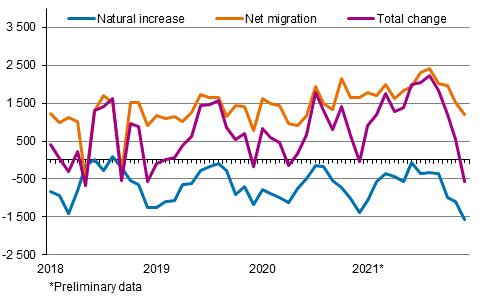Published: 27 January 2022
Birth rate rose from the previous year
According to Statistics Finland's preliminary data, Finland's population at the end of December was 5,549,599. In the course of 2021, Finland's population grew by 15,806 persons. The reason for the population increase was migration gain from abroad: the number of immigrants was 22,305 higher than that of emigrants. The number of births was 7,760 lower than that of deaths.
Population increase by month 2018–2021*

According to the preliminary statistics of December, a total of 49,583 children were born in 2021, which is 3,120 more than in 2020. The number of deaths was 57,343, which is 1,855 higher than one year earlier.
According to preliminary data, the birth rate rose from the previous year. In 2021, the preliminary total fertility rate was 1.46, while in 2020 it was 1.37. The total fertility rate rose for the second year in a row, but it is still the fourth lowest in measuring history. The total fertility rate indicates how many children a woman would give birth to during her lifetime if the birth rate remained the same as in the year on which the calculation is based.
Girls’ life expectancy shortened
The number of deaths was highest on the annual level since 1944. The number of deaths among women was highest since 1919.
According to preliminary data, the life expectancy of newborn boys was 79.2 years and that of girls 84.5 years in 2021. Compared to 2020, the life expectancy of boys lengthened by 0.1 years and that of girls shortened by 0.2 years. Life expectancy is an age-standardised indicator that describes the level of mortality observed during the calculation period. In the final statistics, life expectancy data usually become revised slightly downwards from the preliminary data.
Net immigration exceptionally high
In 2021, altogether 34,445 persons moved to Finland from abroad and 12,140 persons moved abroad from Finland. The number of immigrants was 1,547 higher and the number of emigrants 2,944 lower than in the previous year. In all, 8,129 of the immigrants and 7,996 of the emigrants were Finnish citizens. In 2021, net immigration was exceptionally high, 22,305 persons.
According to the preliminary data, the number of inter-municipal migrations totalled 305,030 in 2021. Compared with the previous year, the increase was 8,178 migrations according to the municipal division of 2021.
According to preliminary data by region, the population grew in 2021 in Uusimaa, Pirkanmaa, Southwest Finland, North Ostrobothnia, Ostrobothnia, Åland, North Savo and Central Finland.
The population grew in absolute numbers most in Uusimaa, where it went up by 12,734 persons. The next highest population increase was seen in Pirkanmaa, 4,717 persons. Relative to the population, population growth was highest in Pirkanmaa, 9.0 per mil and in Uusimaa, 7.4 per mil. The relative population growth was third highest in Åland, 7.1 per mil. In absolute numbers, the population loss was highest in Kymenlaakso, which lost 1,377 persons of its population. The population of Satakunta decreased by 1,089 persons, which was the second highest population loss. The highest population loss in relative terms was recorded in Kymenlaakso, 8.5 per mil.
Most migration gain from intramunicipal and international migration, i.e. total net migration, was recorded in Uusimaa, 7,507 persons and Pirkanmaa, 5,011 persons. Most migration gain in relative terms from total net migration was attained in Pirkanmaa, 9.6 per mil, and Southwest Finland, 6.2 per mil.
In absolute numbers, migration loss from total net migration was biggest in the region of Kymenlaakso, 162 persons. In the region of Central Ostrobothnia the loss was 27 persons. In relative terms, the biggest migration loss from total net migration was found in Kymenlaakso, 1.0 per mil of the population.
Migration loss from migration between regions highest in Uusimaa
In 2021, migration between regions numbered 140,522. Migration gain from migration between regions was recorded by Pirkanmaa, Southwest Finland, North Savo, North Ostrobothnia, Lapland, Kanta-Häme and Central Finland. In absolute numbers, the highest gain from migration between regions was recorded in Pirkanmaa, 3,378 persons. Relative migration gain was highest in Pirkanmaa, 6.4 per mil, and North Savo, 3.0 per mil of the population
Migration loss from migration between regions was highest in absolute numbers in Uusimaa, 2,575 persons. Migration loss from migration between regions was highest in relative terms in Ostrobothnia, 4.1 per mil of the population.
Number of marriages contracted decreased further
According to preliminary data, 19,428 marriages were entered into in 2021, of which 19,056 were marriages of opposite-sex couples and 372 marriages of same-sex couples. Of the same-sex marriages, 264 were between two women and 108 between two men. The number of marriages contracted in 2021 was 2,654 lower than one year earlier.
Source: Preliminary population statistics, Statistics Finland
Inquiries: Auli Hämäläinen 029 551 3615, Joonas Toivola 029 551 3355, Juhana Nordberg 029 551 3051, info@stat.fi
Head of Department in charge: Hannele Orjala
Publication in pdf-format (257.5 kB)
- Tables
-
Tables in databases
Pick the data you need into tables, view the data as graphs, or download the data for your use.
Appendix tables
- Figures
-
- Appendix figure 1. Live births by quarter 1999 - 2020 and preliminary data 2021 (27.1.2022)
- Appendix figure 2. Deaths by quarter 1999 - 2020 and preliminary data 2021 (27.1.2022)
- Appendix figure 3. Intermunicipal migration by quarter 1999 - 2020 and preliminary data 2021 (27.1.2022)
- Appendix figure 4. Immigration by quarter 1999 - 2020 and preliminary data 2021 (27.1.2022)
- Appendix figure 5. Emigration by quarter 1999 - 2020 and preliminary data 2021 (27.1.2022)
Updated 27.01.2022
Official Statistics of Finland (OSF):
Preliminary population statistics [e-publication].
ISSN=2243-3627. December 2021. Helsinki: Statistics Finland [referred: 20.12.2025].
Access method: http://stat.fi/til/vamuu/2021/12/vamuu_2021_12_2022-01-27_tie_001_en.html

